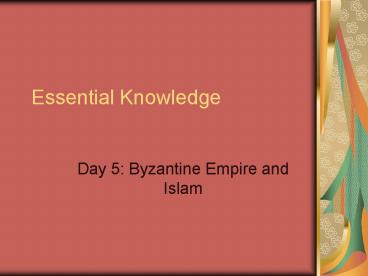Essential Knowledge - PowerPoint PPT Presentation
Title:
Essential Knowledge
Description:
Arial Kimono Essential Knowledge Byzantine Emperor Justinian Byzantine achievements in art and architecture Byzantine culture Eastern Church Western Church ... – PowerPoint PPT presentation
Number of Views:89
Avg rating:3.0/5.0
Title: Essential Knowledge
1
Essential Knowledge
- Day 5 Byzantine Empire and Islam
2
Byzantine Emperor Justinian
- Codification of Roman law (impact on European
legal codes) - Reconquest of former Roman territories
- Expansion of trade
3
Byzantine achievements in art and architecture
- Inspiration provided by Christian religion and
imperial power - Icons (religious images)
- Mosaics in public and religious structures
- Hagia Sophia (a Byzantine domed church)
4
Byzantine culture
- Continued flourishing of Greco-Roman traditions
- Greek language (as contrasted with Latin in the
West) - Greek Orthodox Christianity
- Greek and Roman knowledge preserved in Byzantine
libraries
5
Eastern Church
- Centered in Constantinople
- Close to seat of power after Constantinople
became capital - Use of Greek language in the liturgy
6
Western Church
- Centered in Rome
- Farther from seat of power after Constantinople
became capital - Use of Latin language in the liturgy
7
Division between Western and Eastern Churches
- Authority of the Pope eventually accepted in the
West - Practices such as celibacy eventually accepted in
the West
8
Influence of Byzantine culture on Eastern Europe
and Russia
- Trade routes between Black Sea and Baltic Sea
- Adoption of Orthodox Christianity by Russia and
much of Eastern Europe - Adoption of Greek alphabet to the Slavic
languages by St. Cyril (Cyrillic alphabet) - Church architecture and religious art
9
Origins of Islam
- Muhammad, the Prophet
- Mecca and Medina on the Arabian Peninsula Early
Muslim cities - Spread of Islam
- Across Asia and Africa, and into Spain
- Geographic extent of first Muslim empire
10
Beliefs, traditions, and customs of Islam
- Monotheism (Allah, Arabic word for God)
- Quran (Koran) The word of God
- Five pillars of Islam
- Acceptance of Judeo-Christian prophets, including
Moses and Jesus
11
Geographic influences on the origin and spread of
Islam
- Diffusion along trade routes from Mecca and
Medina - Expansion despite great distances, desert
environments, and mountain barriers - Spread into the Fertile Crescent, Iran, and
Central Asia, facilitated by weak Byzantine and
Persian empires
12
Geographic influences on economic, social, and
political development
- Political unity of the first Muslim empire was
short-lived. - Arabic language spread with Islam and facilitated
trade across Islamic lands. - Slavery was not based on race.
13
Historical turning points
- Sunni-Shia division
- Muslim conquest of Jerusalem and Damascus
- Muslim defeat at the Battle of Tours
14
Cultural contributions and achievements
- Architecture (Dome of the Rock)
- Mosaics
- Arabic alphabet
- Universities
- Translation of ancient texts into Arabic
15
Scientific contributions and achievements
- Arabic numerals (adapted from India), including
zero - Algebra
- Medicine
- Expansion of geographic knowledge































